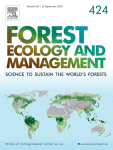View Item
- xmlui.general.dspace_homeCentros Regionales y EEAsCentro Regional MisionesEEA Cerro AzulArtículos científicosxmlui.ArtifactBrowser.ItemViewer.trail
- DSpace Home
- Centros Regionales y EEAs
- Centro Regional Misiones
- EEA Cerro Azul
- Artículos científicos
- View Item
Changes in spider diversity through the growth cycle of pine plantations in the semi-deciduous Atlantic forest: The role of prey availability and abiotic conditions
Abstract
The replacement of native forests by tree plantations affects the diversity of biological communities, particularly in highly diverse tropical and subtropical ecosystems such as the semi-deciduous Atlantic forest. Previous studies in this ecosystem have focused on vertebrates, while only a few studies have been performed on the relationship between spiders and pine plantations. We aimed to estimate changes in spider richness and species composition over
[ver mas...]
The replacement of native forests by tree plantations affects the diversity of biological communities, particularly in highly diverse tropical and subtropical ecosystems such as the semi-deciduous Atlantic forest. Previous studies in this ecosystem have focused on vertebrates, while only a few studies have been performed on the relationship between spiders and pine plantations. We aimed to estimate changes in spider richness and species composition over the course of a pine plantation forestry cycle of 15 years. We expected that the increase in environmental similarity (vegetation, prey availability) between native forest and tree plantations through the plantation growth cycle would promote its use by native spider species. We used six collection methods to characterize the spider assemblages and their potential prey in five replicates of native forest and pine plantations of three different ages representing the forest cycle (1–2, 5–6, 10–11 years old). Additionally, we described vegetation structure and recorded ground temperature and humidity during the sampling period. Analyses were carried out combining spiders from all sampling methods and independently on each vertical stratum. As expected, spider richness increased and the dissimilarity in relation to the native forest spider community decreased through the growth cycle of the pine plantation, associated with an increase in potential prey abundance and richness (but not vegetation structure). The response of spiders on each stratum showed interesting trends; opposite to the general pattern, in young plantations the ground strata exhibited a rich and distinctive spider assemblage while herbaceous strata showed similar diversity (richness and species composition) in all three plantation ages. Our results showed a rapid increase in spider richness in the first 6–7 years after plantation and a subsequent stabilization. Also, the proportion of native species in plantations increased from 6% in the first years to 34% and then remained constant until cutting age (11–12 years). Differences in species composition were mainly due to both differences in richness and species composition in young plantations, while in middle-aged and mature plantations it was mainly due to species replacement. The increase in prey abundance (and probably the increase in vegetation complexity and the decrease of extreme microclimatic conditions) through the plantation cycle increase the suitability for native forest species. However, a deeper understanding of the ecological and physiological requirements of spiders is necessary to improve the ability of tree plantations for native diversity.
[Cerrar]

Author
Munevar Lozano, Ana Katerinne;
Rubio, Gonzalo Daniel;
Zurita, Gustavo Andres;
Fuente
Forest ecology and management 424 : 536-544 (September 2018)
Date
2018-09-15
ISSN
0378-1127
Formato
pdf
Tipo de documento
artículo
Palabras Claves
Derechos de acceso
Restringido
 Excepto donde se diga explicitamente, este item se publica bajo la siguiente descripción: Creative Commons Attribution-NonCommercial-ShareAlike 2.5 Unported (CC BY-NC-SA 2.5)
Excepto donde se diga explicitamente, este item se publica bajo la siguiente descripción: Creative Commons Attribution-NonCommercial-ShareAlike 2.5 Unported (CC BY-NC-SA 2.5)

